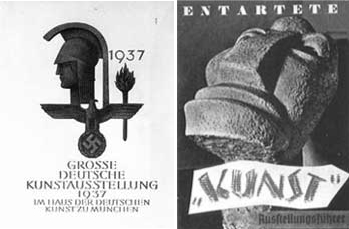Subject 2: Contextualizing Cultural Artefacts
Equally important in Culture and History is the ability to contextualize cultural artefacts, putting them into relation with one another, and to synthesize your interpretations into larger frames of understanding. Very often the most interesting and important kinds of contextualization are matters of dispute.
The following exercise asks you to practice comparing and contextualizing two images (Figures 1 and 2, right).
Art during the Nazi period
In 1937, the Nazi regime, under the guidance of Joseph Goebbels’ Ministry for Popular Education and Propaganda, opened two art exhibitions in Munich. The first, the “Great German Art Exhibition” (“Groβe Deutsche Kunstausstellung”), was intended to promote and support artworks and artists that the Culture Ministry saw as embodying National Socialist ideals of racial purity, national unity, and popular accessibility. The second, “Degenerate Art” (“Entartete Kunst”), was intended by contrast to display artworks and artists that, in terms of official Nazi ideology, showed signs of “racial contamination”, were dangerously individualistic, or were too elitist and esoteric to contribute to the development of a national culture. After half a year, “Degenerate Art” received more than three times the number of visitors as the “Great German Art Exhibition.”

Figure2: A program guide for the “Degenerate Art Exhibition”